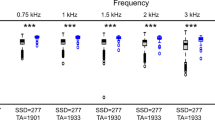Abstract
Hearing loss in Menière’s disease has been described to affect above all low frequencies (upward curve) with a tendency to become irreversible and non-fluctuating at the higher frequencies (peaked curve) over time. The aim of the study was to determine the effects of MD on hearing function on the basis of differences existing between the affected and the unaffected ear in a group of patients affected by definite unilateral MD and whose contralateral ear was not affected by any disease other than age-related hearing loss (ARHL). Following this procedure we have also evaluated the possible effects of age and disease duration on hearing loss in MD. The study group consisted of 86 subjects affected by definite unilateral MD. In our sample a peaked audiometric curve characterized the affected ears; however, the result after subtracting the normal ear hearing threshold was an upward sloping curve, which highlighted the greater suffering at the lower frequencies. On the basis of differences existing between affected and unaffected ear, our data suggest that threshold evolution is more related to disease duration rather than to age.



Similar content being viewed by others
References
Shojaku H, Watanabe Y, Fujisaka M, Tsubota M, Kobayashi K, Yasumunas S, Mizukoshi K (2005) Epidemiologic characteristics of definite Menière disease in Japan: a long term survey of Toyama and Niigata prefectures. ORL J Otorhinolaryngol Related spec. 67(5):305–309
Watanabe Y, Mizukoshi K, Shojaku H, Watanabe I, Hinoki M, Kitahara M (1995) Epidemiologic and clinical characteristics of Menière disease in Japan. Acta Otolaryngol (Stockh) 115(suppl 519):206–210
Mc Neill C, Cohen MA, Gibson WPR (2009) Changes in audiometric threshold before, during and after attacks of vertigo associated with Menière’s syndrome. Acta Otolaryngol 129:1404–1407
Committee on Hearing and Equilibrium of the American Academy of Otolaryngology Head Neck Surgery (1995) Guidelines for the diagnosis and evaluation of therapy in Menière disease. Otolaryngol Head Neck Surgery 113:181–185
Stahle J, Friberg U, Svedberg A (1991) Long term progression of Menière’s disease. Acta Otalaryngol Stochk Suppl 485:78–83
Belinchon A, Perez-Garrigues H, Tenias JM, Lopez A (2010) Hearing assessment in Menière’s disease. The Laryngoscope 121:622–626
Huppert D, Strupp M, Brandt T (2010) Long term course of Menière’s disease revisited. Acta Otolaryngol 130:644–651
Mancini F, Catalani M, Carru M, Monti B (2001) History of Menière’s disease and its clinical presentation. Otolaryngol Clin North Am 35:565–580
Franco-Vidal V, Legarlantezec C, Blanchet H, Convert C, Torti F, Darrouzet V (2005) Multifrequency admittancemetry in Ménière’s disease: a preliminary study for a new diagnostic test. Otol Neurotol 26(4):723–727
Ferraro JA, Durrant JD (2006) Electrocochleography in the evaluation of patients with Ménière’s disease/endolymphatic hydrops. J Am Acad Audiol 17(1):45–68
Acknowledgments
The study was carried out thanks to the Italian Association of Meniére’s Disease (AIMM).
Conflict of interest
The Authors declare that they have not a financial relationship with the organization that sponsored the research.
Author information
Authors and Affiliations
Corresponding author
Rights and permissions
About this article
Cite this article
Albera, R., Canale, A., Cassandro, C. et al. Relationship between hearing threshold at the affected and unaffected ear in unilateral Meniere’s disease. Eur Arch Otorhinolaryngol 273, 51–56 (2016). https://doi.org/10.1007/s00405-014-3466-8
Received:
Accepted:
Published:
Issue Date:
DOI: https://doi.org/10.1007/s00405-014-3466-8




